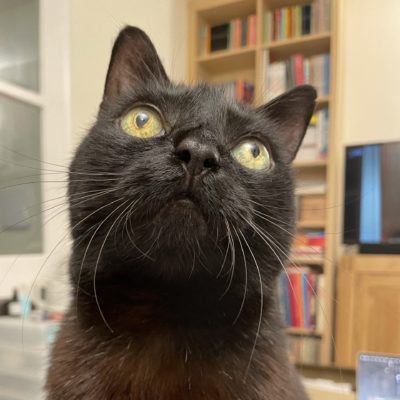I once travelled with Chloe on a public bus when a fellow passenger suddenly struck out at Chloe with a rolled-up newspaper.
Fear of cats does not justify behaviour like this. Chloe was stationary on my shoulder and doing nothing wrong.
An assistance animal owner relies on their animal to help address their disability and achieve independence. An appropriately-trained assistance animal will not climb furniture and bother other people.
Allergic disease caused by dogs appears to be less common than that caused by cats. However, this reported difference may be down to skin testing challenges to detect dog sensitivity.
With cats, the biggest problem is a small, sticky protein called Fel d1. This attaches itself to dried skin, called dander, that flakes off and floats through the air when cats wash themselves. It then clings to surfaces like curtains, carpets, furniture, bedding, clothing, and even walls and ceilings.
Research has shown that Fel d1 is found in almost all American homes, including those where there are no cats. The same study found the canine equivalent protein, Can F1, in all of the homes tested. Pet dander is also found in all public places and on public transport.
Research has shown that dogs and cats are less likely to bring on an allergic reaction than dust mites, pollen, paint and cleaning products.
Allergies and fear of dogs are not valid reasons for denying access or refusing service to assistance dogs, and the same should be true for assistance cats also. However, there is plenty that a responsible assistance cat owner can do to minimise risk.
The first thing to consider is that neutered, female cats produce lesser concentrations of Fel d1 and unneutered males the most. In 2000, a study suggested that dark-coloured cats made more Fel d1 than light-coloured. Later studies have shown colour has no impact.
Regular grooming will reduce the amount of Fel d1 on a cat. Wiping away the dander with a product called PetAlCleanse will also help. This lotion, composed of cleansers and moisturisers, remove the dander saliva and urine from the coat and encapsulates the Fel d1 allergens. Tests have shown that PetAlCleanse alleviated the symptoms of 90% of sufferers.
A newer, lesser-known option is to feed your cat Purina LiveClear. This is a dry food that uses an egg product to neutralise the Fel d1. However, do ensure you are comfortable with the relatively high amount of carbohydrates in the food.
References
- Fel d 1 and Fel d 4 levels in cat fur, saliva, and urine (Journal of Allergy and Clinical Immunology)
- Dog allergen (Can f 1) and cat allergen (Fel d 1) in US homes: results from the National Survey of Lead and Allergens in Housing (Ann Allergy Asthma Immunol)
- Cat (Fel d 1) and dog (Can f 1) allergen levels in cars, dwellings and schools (Aerobiologia (Bologna))
- A Study on Indoor Air Contaminants Related to Pets in Japanese Dwellings (Journal of Asian Architecture and Building Engineering) [PDF]
- Domestic allergens in public places. II: Dog (Can f1) and cockroach (Bla g 2) allergens in dust and mite, cat, dog and cockroach allergens in the air in public buildings (Clin Exp Allergy) [PDF]
- Domestic allergens in public places III: house dust mite, cat, dog and cockroach allergens in British hospitals (Clin Exp Allergy) [PDF]
- Cat allergen levels in public places in New Zealand (The New Zealand Medical Journal)
- Dog and Cat Allergies: Current State of Diagnostic Approaches and Challenges (Allergy Asthma Immunol Research)
- Information on allergies and fear of guide dogs (RNIB) [PDF]
- Living with cat allergies (Cats Protection)
- PetalCleanse (Bio-Life International)
- Pro Plan LIVECLEAR (Purina)
Further reading
- Immunization of cats to induce neutralizing antibodies against Fel d 1, the major feline allergen in human subjects (Journal of Allergy and Clinical Immunology)
- Feeding cats egg product with polyclonal- anti-Fel d1 antibodies decreases environmental Fel d1 and allergic response: A proof of concept study (Journal of Allergy and Infectious Diseases) [PDF]
- A novel approach to the reduction of cat allergen Fel d1 through inclusion of an egg product ingredient containing anti-Fel d1 IgY antibodies in the feline diet (European Academy of Allergy and Clinical Immunology (EAACI) Congress)
